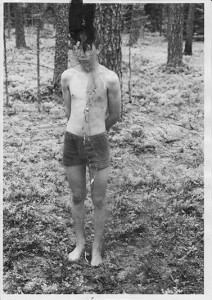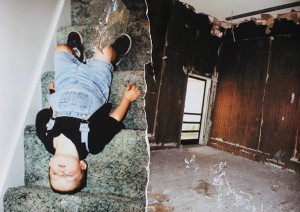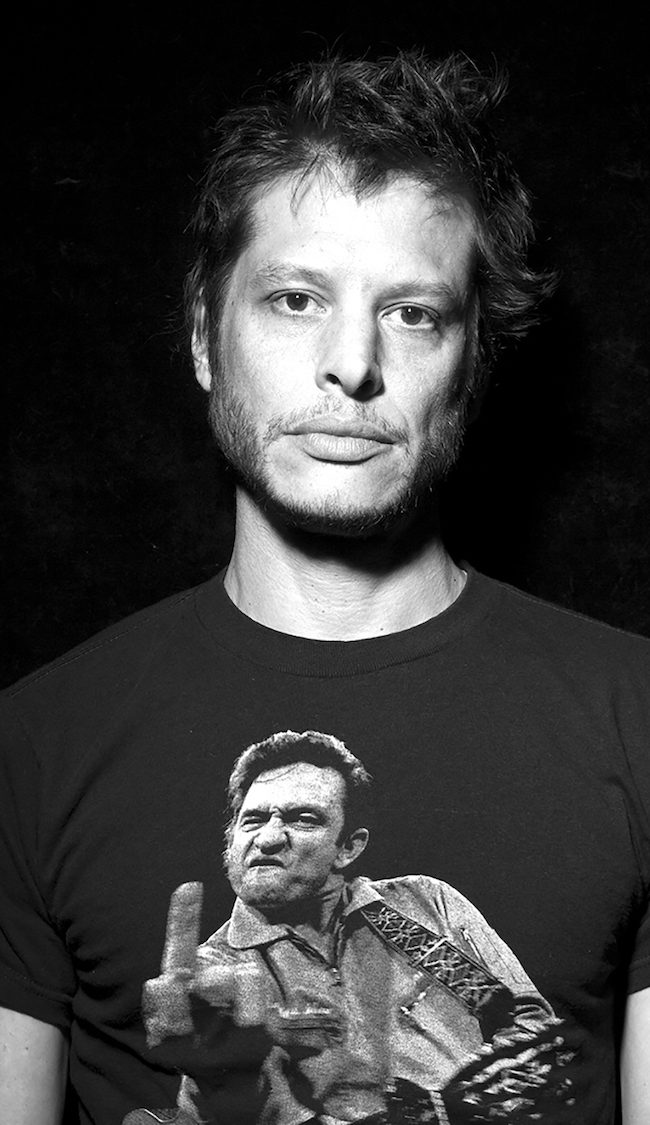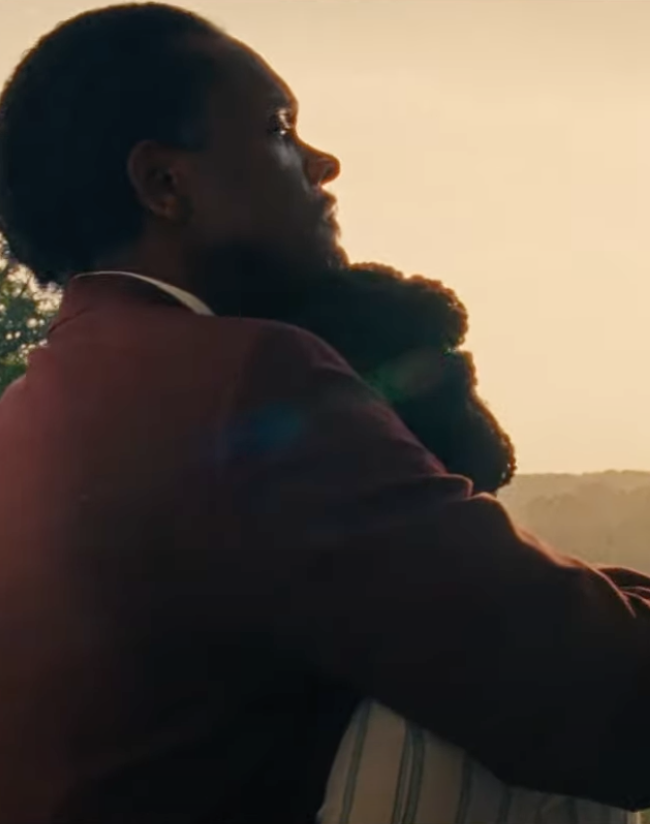Nick Toti’s “Digital Gods”- Transmission Seven.Five
 (If you didn’t read the previous Digital Gods entry on Michael Salerno’s Kiddiepunk Cartoons, you should probably read it now or watch the series before reading Nick Toti’s interview with series creator Michael Salerno the second half of which is below. The first half is here.)
(If you didn’t read the previous Digital Gods entry on Michael Salerno’s Kiddiepunk Cartoons, you should probably read it now or watch the series before reading Nick Toti’s interview with series creator Michael Salerno the second half of which is below. The first half is here.)
HtN: How long did Kiddiepunk Cartoons take to complete?
MS: All up, just under three years. Not of solid work, but kind of staggered work. It took quite a long time just to figure out the right way to fit all the pieces together. It ended up being a series of eight short films, but originally it was supposed to be just one film. I had all of these pieces, some of them were quite experimental, some were in a more traditional interviewer/subject documentary format, but all these pieces never quite worked when they were part of the same thing. So I kind of left it alone for a while and just thought to myself, “Okay, maybe this movie just isn’t going to work out.” After some downtime, it occurred to me that they could be individual parts of a greater whole, like episodes of a TV show, which is why I decided to make them part of a series.
HtN: To me they feel less like episodes in a series than movements in a piece of music. Or songs on a very tightly-constructed album. I know that you’re also a musician…do you see a connection between these two creative impulses?
MS: Oh, for sure. The sound and the image is so deeply connected to me. I don’t know how people edit their movies without sound. I need all that stuff done before I start editing, as it completely dictates the rhythm and pacing of the edit. I do that no matter what style of thing I’m cutting (fiction or nonfiction) but especially with these kinds of films which are all about mood, rhythm, feeling. It’s super important.
HtN: How did you find the people who you interviewed?
MS: I initially put out a call on Facebook for anyone who might know someone who has had tornado encounters, then I had an assistant who was reaching out to people on Reddit and places like that. When I flew over to Oklahoma, I had only a relatively small group of people lined up for interviews, but when I arrived and started talking to people, everyone I was talking to was putting me in contact with other people, their friends, neighbors, etc., which is what I hoped for. I mean, when one of these massive tornadoes hits, everyone in that area is affected, so if you just go there, everyone’s going to have a story to tell. I ended up interviewing a lot of people, there’s hours of interviews with people that didn’t make it into the final films.
HtN: Any plans for future usage of this unused material?
MS: No, I don’t think so. There’s a lot of stuff that’s like, you know, just people talking about tornadoes. If I was Ken Burns I’d have my 3-part PBS mini-series sorted, but I was trying to make a film about childhood, so whatever couldn’t be skewed to that aim was thrown out.
HtN: Did you encounter any resistance from the people whose misfortune you were documenting?
MS: No, everyone I spoke with was really great. We were in Moore a few months after the May 20th 2013 tornado which was one of the biggest ever recorded. The actual tornado itself was over a mile wide, so big that many people I spoke to didn’t even realize that this big black mass they were seeing in the sky was the actual tornado itself. Moore has been almost wiped off the map numerous times over the decades by these things. So, I was expecting a lot of tears and melodrama, but in fact the vast majority of people were pretty chilled about it, for the most part. It was like, “Okay, my house and all of my belongings are gone, but we’re all okay, so we better just pick ourselves up and get on with rebuilding.” It’s a part of life there. Even though you could see the devastation all around, entire neighborhoods turned to piles of trash, and you could see evidence of these people being traumatized, they were just focused on trying to put the pieces back together. But I really loved the people from Moore, some the kindest, most generous people I’ve ever met, and I felt comfortable there too as there’s a visual similarity to parts of Melbourne (Australia) where I grew up.
HtN: There’s a sort of framing device of a young man who shows up throughout the series. Who was this and how do you see him fitting into the “narrative?”
MS: Yeah, there’s a story that runs through the series of a teenage boy and his younger brother. The boys were hit by the tornado and the younger brother was killed, so the older brother is kind of processing both the loss of his brother as well as the devastation all around him in the aftermath of the tornado. This also reflects another film of mine called Elri Paints Himself as a Tornado which is connected to the Cartoons series. Like I’ve said before, these films are really all about childhood to me and the destruction of childhood, memory, trauma… all that kind of stuff.
HtN: It’s interesting to me that you intended the older brother to be the survivor. I saw it as more ambiguous. At times it seems like maybe the younger brother is the survivor or maybe even they both survived but are so traumatized that they’re almost like different people now (or, as episode one suggests, zombies!).
MS: Sure, I think this little storyline is abstract enough where there’s room to stretch your legs out inside it or take it in different ways. The specifics are not what’s important. The emotion, the feeling is important.

HtN: I’ve watched the last episode at least three times now and I still can’t make out half of what’s being said. Any hints?
MS: The older brother is recounting a story. I have a kind of self-regulating paranoia about things appearing too obvious, so maybe the ambiguity partly stems from that, but also, the last episode is really personal. It takes place somewhere different from the other episodes. It’s way down there, somewhere very deep, formless. It’s an abstract place. I was just trying to nail the feeling and sometimes the words being too clear felt like it could throw the balance off or create a distraction.
HtN: Kiddiepunk Cartoons has a very distinct texture, which is especially striking since digital filmmaking often produces a sort of flat, generic look. How did you accomplish this?
MS: I kind of view these films as an extension of my work as an artist, and I was interested in trying to see what would happen if my still images, my photographs and collages, could move. So it really stemmed from that more than anything. I was just trying to expand a mood that I had in my head.
I sometimes like re-photographing my images and I do it quite a bit in my work. With these films, I wanted this haze or pressure to be hanging over the images like a permanent fog. Everyone that I’ve spoken to, and in all of my research about tornado survivors, they all talk about this kind of altered consciousness that takes place immediately after a tornado hits. You wake up bleeding and look around, and your house, your street, your entire neighborhood looks like it’s been put into a blender. People are wandering around bleeding, injured, disoriented. They’re in shock. So I tried to convey that feeling in these films. I was trying to capture the effects of living through a destructive tornado, but on an interior or feeling level. One of the ways I did this was to use this technique, which also gives a feeling of fragility to the images that I like, a feeling that they could just disintegrate altogether.
HtN: How does Kiddiepunk Cartoons tie in with your larger Kiddiepunk project?
MS: Kiddiepunk is a small press that I run. We publish books and zines mostly, but also produce film and video projects. The press mostly releases work that is centered around the theme of childhood in some way, so these films fit in perfectly. When I decided that these were going to be in episode form, I got really into the idea that they would be like real cartoons. I imagined people waking up on a Saturday morning and watching the latest episode with a bowl of cereal in their hands, like you do when you’re a kid. For a long time I was very into black and white or a kind of subdued color palette in my work, and this past year I really got excited about using colors, so each one of these episodes has it’s own color scheme and mood going on. Kind of like a box of mixed candy.
HtN: I actually did watch each new episode as I ate breakfast before work.
MS: Well, I’m really happy to hear that! Mission accomplished, I guess.
HtN: Having a foot in both worlds, do you have any thoughts on how independent publishing connects with (or potentially could connect with) independent cinema?
MS: Well, I can only speak for myself, but it’s always made sense to me to both work in a variety of mediums and also to connect these things together. And Kiddiepunk has become a nice little home for all of these things. I like to think of it as one big, ever-evolving artwork that involves not only my own work but also that of other people. The connecting tissue is the overall aesthetic and the thematic focus.
HtN: Do you have any advice from your experience on the publishing/distribution end for people looking to build an audience for their own idiosyncratic or experimental work? How do you balance the creative side of the work with the promotional side?
MS: My approach has always been that it’s better to put my energy into setting up things for myself, rather than trying to have my work be accepted into some other system. Figuring out all of this stuff can be tricky, but in a nutshell that’s generally the way I approach stuff, with a kind of punk attitude. It’s more empowering that way. We have all the tools at our disposal to reach people and start our own communities, so my advice would be for people to do that, especially when you make work that doesn’t easily fit, like I do. As far as balancing creative and promotional sides, I think you need to find a way for it to all be creative, so it’s all one thing, not separated.
HtN: Does your creative work sustain you or do you have a day job?
MS: It’s not a day job, per se. I do various things to earn money, mostly designing book covers, but also collaborating on theatre or opera productions here in France.
The last couple of years I’ve been lucky enough to actually make some money from my art and film stuff, but I don’t rely on that to make me a living. As a general rule, I feel it’s better to not be reliant on your art to make you an income. It keeps things pure that way, because you just do what you love and do it exactly the way you want, without compromise. You don’t need to be concerned with pleasing anyone but yourself. I’ve also always had the attitude that one shouldn’t wait around for someone to magically appear and give them money to make their art. If I did that, I would never have made anything.
HtN: Does that mean you self-finance your movies?
MS: Yes, I do. There’s a lot of filmmakers that believe you should never put your own money into your films because you never get it back, but I disagree. It may be true that you never get it back, but at the end of the day, you have your film and it probably wouldn’t exist without you making it happen yourself. Up until now, the ideas I’ve had have all been relatively affordable to make, so I’ve always done that, but I’m at a bit of a crossroads now because a couple of these new film projects that I’ve written are going to need a lot more money than I could afford myself, so I’ll be needing to beat down a different path with those.
HtN: Do you have a goal for your filmmaking career? Is all this leading to a big Michael Salerno directed Captain America sequel?
MS: Haha! I’d say the chances of that happening are pretty much non-existent. I’m really into original ideas and I don’t think I could make something that I didn’t write myself. The “goal” is really just to keep doing the things that I want to do. I get ideas and images in my head and I feel this intense compulsion and need to see them exist in the world. Lately, I feel like I’m entering a bit of a new phase, so I’m excited about venturing out into new places with my work and operating in slightly different ways than I have in the past. We’ll see…
– Nick Toti (@NickTotiis)











